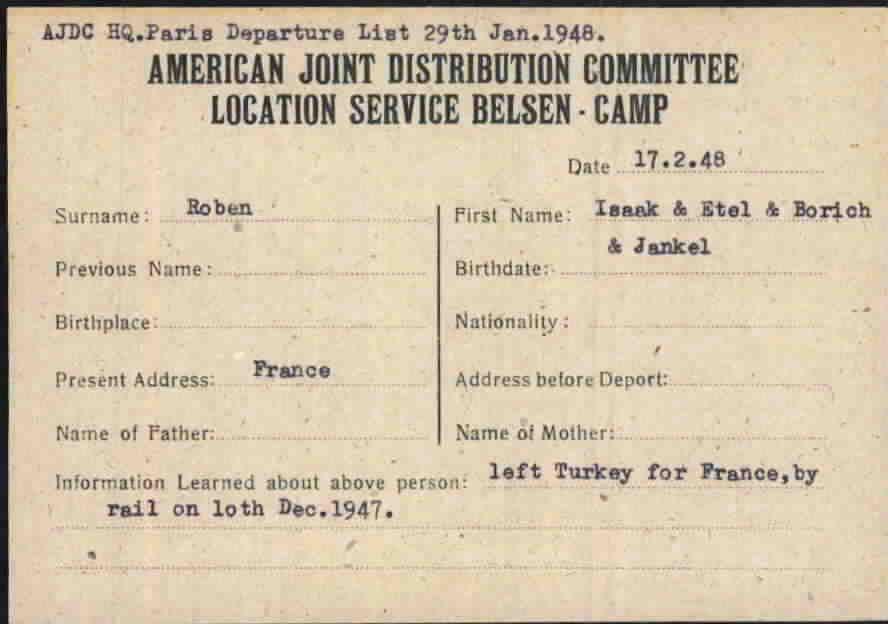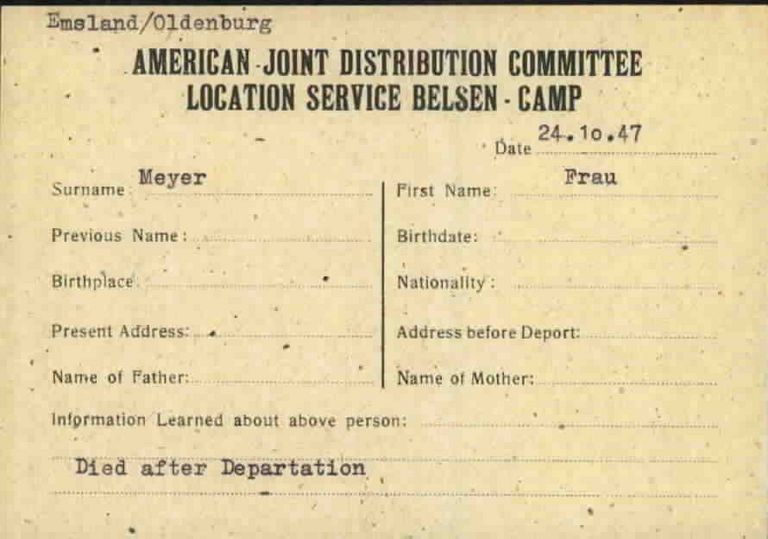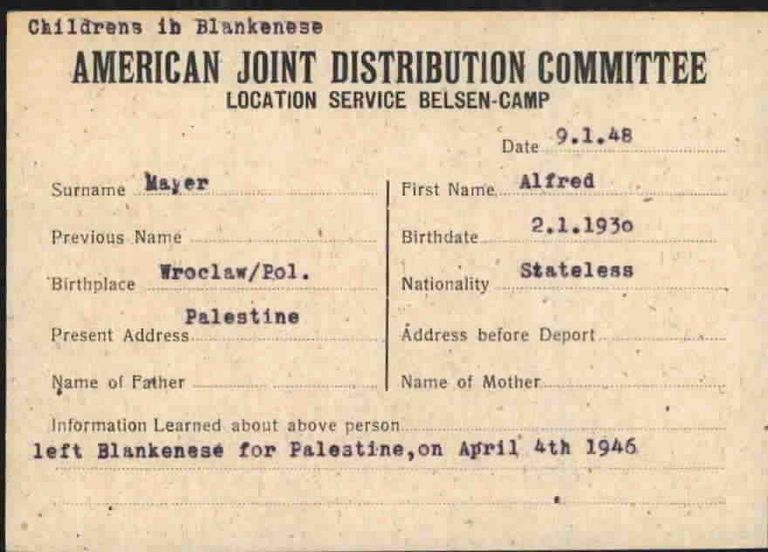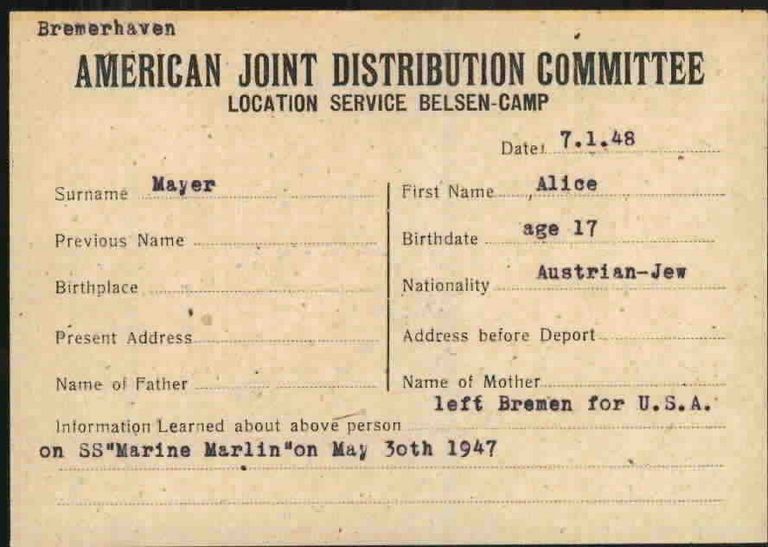Page of
Page/
- Reference
- Intro


The employees of the Location Service of the American Joint Distribution Committee (AJDC) in the Bergen-Belsen DP camp created a special card for tracing missing persons. They used this card to note information they had gathered on Holocaust survivors.
The card helped them process tracing inquiries more quickly. Some of the information on the cards is very precise, but in other cases only rough information was available. The cards all look very similar; there are just small differences in the typeface used.
The employees of the Location Service of the American Joint Distribution Committee (AJDC) in the Bergen-Belsen DP camp created a special card for tracing missing persons. They used this card to note information they had gathered on Holocaust survivors.
The card helped them process tracing inquiries more quickly. Some of the information on the cards is very precise, but in other cases only rough information was available. The cards all look very similar; there are just small differences in the typeface used.
Questions and answers
-
Where was the document used and who created it?
When the American Jewish Joint Distribution Committee (known as Joint, JDC or AJDC for short) started caring for Jewish Displaced Persons (DPs) after World War II, the organization already had more than 30 years of experience. The AJDC had been founded in the USA in 1914, at the start of World War I, to provide support to Jewish men and women worldwide. Between 1945 and 1950 alone, the organization provided more than 300 million US dollars worth of aid gathered through donations.
The AJDC had its headquarters in Washington, but there were field offices around the world. In mid-July 1945 the AJDC also opened an office in the Bergen-Belsen DP camp, which was located just two kilometers from the former concentration camp. The DP camp soon developed into a center of Jewish life; more Jewish DPs lived there than anywhere else in occupied Germany. The first five AJDC employees there worked with 12 volunteers from the British Jewish Relief Unit (JRU) to care for the DPs on site. This also involved searching for missing persons. To this end, the employees of the AJDC Location Service consulted various sources of information and transferred all of the details they could find about a person – even vague information – to special cards. These cards formed a card index that was used to search for Jewish victims of persecution.
- When was the document used?
It is not possible to say exactly when the AJDC employees in the Bergen-Belsen DP camp started creating the card file. However, two key dates in the use of the card file are known: the end of July 1945 and August 1954. The AJDC did not start working on behalf of Jewish survivors of the Bergen-Belsen concentration camp immediately after the end of the war. It was not until late July 1945 that the AJDC was able to take up work in the Bergen-Belsen DP camp. Therefore, this is also the earliest point at which the card file could have been established. The Bergen-Belsen DP camp held around 9,000 Jewish survivors at the time, making it the largest Jewish DP camp in Germany.
In 1949, the AJDC office moved from Bergen-Belsen to Hamburg. It is not known whether the card file of the Location Service was still being used at this point. However, the issue date on most of the cards is 1948.
By May 1949 at the latest, plans were being made to take the AJDC documents to Arolsen. A very large number of AJDC documents were also transferred to the ITS in the late 1940s and early 1950s, as the search for missing victims of persecution had been centralized there. The cards of the Location Service Belsen probably arrived at the ITS at this time as well. The date stamped on the back of the cards by ITS employees shows that the cards were placed in the postwar card file (Nachkriegszeitkartei, Collection 3.1.1.1) from August 1954 onward. By this point at the latest, the cards of the AJDC Location Service Belsen were also being stored in Arolsen, but they were no longer being updated.
- What was the document used for?
After the end of the war, the largest DP camp for Jewish Holocaust survivors in the British occupation zone was established right near the former Bergen-Belsen concentration camp. In addition to providing food, medication and clothing, the AJDC – in cooperation with other aid associations such as the Organization for Rehabilitation and Training (ORT) – developed a wide range of support activities over time. For example, AJDC employees set up kindergartens and schools in the Bergen-Belsen DP camp for Jewish children and adolescents, and they acquired the technology needed for vocational training. The leisure program became increasingly varied as well. The AJDC organized film screenings and established a library, and it purchased sports equipment and a printing press for the DP newspaper. Observant Jews had access to religious texts and kosher food.
In addition to this, however, it was always important to the survivors to find out more about the fate of their relatives and acquaintances. Jacob Trobe, the AJDC director in Germany, observed that “many [survivors] do not want to migrate until they have searched all Germany and Eastern Europe for missing relatives” (quoted in Sara Kadosh and Eric Nooter: “The American Jewish Joint Distribution Committee and Bergen-Belsen,” in: Erik Somers and René Kok [eds]: Jewish Displaced Persons in Camp Bergen-Belsen 1945–1950. Zwolle 2004, p. 112). Employees of the AJDC Location Service therefore organized tracing activities to find missing Jewish family members and acquaintances. The office in the Bergen-Belsen DP camp was part of a worldwide network of tracing offices run by the AJDC and other organizations. The AJDC Location Service Headquarters was located in Paris. From there, tracing inquiries were forwarded to the AJDC field offices, which were scattered all over Europe, including in Vienna, Brussels and Warsaw. However, field offices were set up outside of Europe, too, such as in Shanghai.
The AJDC Location Service Belsen, like other tracing offices, had also created its own card file which the employees used to trace missing persons. Everything known about a person’s fate was noted on the cards. This information could be very vague, such as “woman” instead of a forename, or “age 17” instead of a precise date of birth. The information was therefore probably not gathered by questioning survivors but was instead taken from various lists. A report from August 1945 states that, even prior to this, the AJDC had “good lists of former inmates as well as lists of present inhabitants, lists from other camps and [they] are now receiving lists of relatives of DPs surviving in their home countries” (1.1.3.0/82350945, ITS Digital Archive, Arolsen Archives). When an inquiry from the headquarters or another office was received in Bergen-Belsen, AJDC employees searched the local card file. Under certain circumstances, letters were written to other tracing offices, too. All of the information they found was noted in a document known as Form No. 3. The form was sent to Paris, where all search findings were gathered in a card file. This card file comprised around 400,000 cards in December 1947.
- How common is the document?
It is not possible to say exactly how many cards from the AJDC Location Service Belsen are held in the Arolsen Archives. This is because the cards were not stored together in their own card file; instead, ITS employees filed them with other documents in the postwar card file (Nachkriegszeitkartei, Collection 3.1.1.1) following an alphabetical-phonetic system. This simplified the process of searching for references to individuals, but as a result, it is no longer known how common the cards are from the AJDC Location Service Belsen. But in the near future, modern computer technology will find the answer: clustering techniques will make it possible to virtually reassemble the cards of the Location Service Belsen – as well as other card files.
- What should be considered when working with the document?
The cards were designed to record a lot of information. However, the address fields and fields for the parents’ names were often left blank.
If you have any additional information about these cards, we would appreciate it very much if you could send your feedback to eguide@arolsen-archives.org. New findings can always be incorporated into the e-Guide and shared with everyone.
Help for documents
About the scan of this document <br> Markings on scan <br> Questions and answers about the document <br> More sample cards <br> Variants of the document



